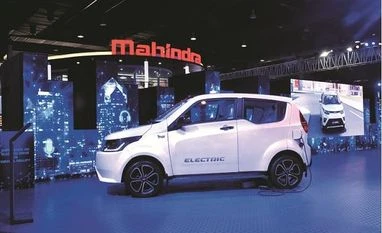The world’s auto makers are vying to build an affordable electric car to target drivers in emerging economies and potentially create a competitor to Chinese-made vehicles.
They need to radically reduce sticker prices for electric vehicles to around $7,000 to entice the average buyer and sell enough cars to have a meaningful impact on emissions.
At India’s Auto Expo this month, held on the outskirts of New Delhi, there were 25 electric vehicles on display, up from just a handful at the last show two years ago. Toyota MotorCorp. , Hyundai Motor Co. , Renault SA, Kia Motors Corp. and other car makers displayed their latest EVs for the 600,000 potential car buyers who visited the expo. They unveiled models for the first time in India and pledged to have many on Indian roads in the next three years.
There are currently fewer than 10,000 electric vehicles on Indian roads. Car companies need to bring down the relatively high price of EVs, because most consumers in India and other emerging markets won’t pay extra to go green, according to EV-Volumes, which tracks electric-vehicle sales.
“The environmental benefit has to come for free,” said Pawan Goenka, managing director at Mahindra & Mahindra Ltd. , on the sidelines of the auto show, where the Indian car maker unveiled six electric vehicles. While less-affluent buyers are interested in EVs, they are unwilling to sacrifice on performance or pay much more to buy or run them, he said.
Industry executives say that for people to switch to electric cars, their price tags have to be comparable to regular cars, the most popular of which in India cost between $6,000 and $8,000. High battery prices are one of the main hurdles for companies trying to build cheaper electric cars.
In the U.S., the best-selling electric vehicles tend to cost more than $30,000. Globally, some electric vehicles sell for less than $10,000, but only after large government subsidies and rebates.
In China, the world’s largest electric-car market, the Baojun E100—made by a joint venture between General Motors Co. and SAIC Motor Corp. —sells for as little as $6,500, but only after more than $7,000 in government incentives. Such concessions helped push China’s sales of electric cars to more than 600,000 last year—three times the number sold in the U.S. and half the 1.2 million in EV sales globally. The Chinese market is dominated by local brands that aren’t big exporters yet. In India, the Mahindra e2o sells for around $9,500 after more than $4,000 in government incentives.
To create enough demand to reach the economies of scale that would bring prices down further, governments need to continue subsidizing consumers while they spend billions building necessary infrastructure such as charging stations, industry executives say.
“We need (China’s) single-minded focus to push electric vehicles” in India, said Guenter Butschek, chief executive of Tata Motors Ltd. , India’s largest auto maker by revenues and the owner of Jaguar and Land Rover. “As the sales volume of mild hybrid and EV in other markets—especially China—ramp up, costs will reduce, making it easier to further grow our market.”
India’s EV market is expected to take off in the next decade, as New Delhi has pledged to use policy and tax incentives as well as build infrastructure to radically increase the number of electric vehicles in use. Some policy makers hope to make all new vehicles on the road electric by 2030, a tough target to reach without lower prices.
At the auto show, Tata Motors, which set new standards for affordability with its conventional $2,000 Tata Nano some years ago, had six EVs for people to look at.
It already provides electric buses and passenger cars to the government and hopes to sell them to the general public in the next three years.
Some of the design tricks Tata uses to make its regular cars less expensive were incorporated into the electric vehicles it had at the show.
Its tiny electric van, for example, had the gear shift incorporated into the dashboard and flexible, clear plastic windows that zip open and shut.
Meanwhile, Mahindra holds down the prices of its electric vehicles by making them as small and light as possible with plastic exteriors.
Foreign manufacturers can offer electric cars in emerging markets more cheaply if they build them locally instead of depending on imports, which are often expensive and highly taxed, analysts say.
Auto companies are also betting prices will fall as technology improves and a new wave ofbattery-making capacity comes online and forces further competition.
Batteries are perhaps the most important component in car makers’ quest to create an affordable EV.
At current battery prices, an electric version of Suzuki’s best-selling Alto model, for example, would theoretically cost more than double the standard $5,500 price, said Kenichi Ayukawa, chief executive of Maruti Suzuki, which dominates the Indian passenger car market with close to a 50% market share.
Suzuki plans to launch an EV for the Indian market in 2020, but it is unlikely to be a big seller unless costs fall, he said.
“The battery cost is still very expensive. We need more improvement in that area,” Mr. Ayukawa said.
“As long as we cannot provide an affordable price, the customer will not buy.”
(Anant Vijay Kala contributed to this article.)
Unlock 30+ premium stories daily hand-picked by our editors, across devices on browser and app.
Pick your 5 favourite companies, get a daily email with all news updates on them.
Full access to our intuitive epaper - clip, save, share articles from any device; newspaper archives from 2006.
Preferential invites to Business Standard events.
Curated newsletters on markets, personal finance, policy & politics, start-ups, technology, and more.
)